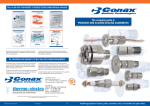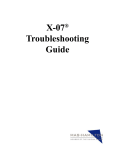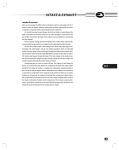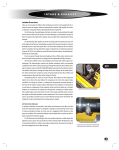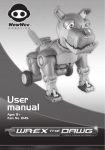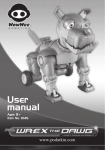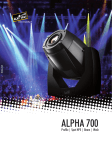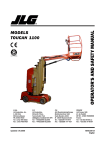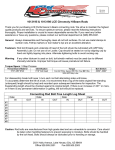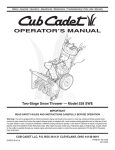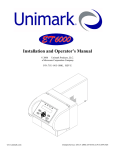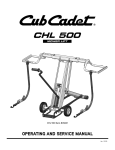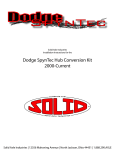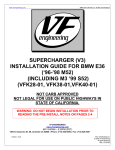Download PARTS, DRAWINGS, SERVICE & OPERATION MANUAL
Transcript
T-WREX PARTS, DRAWINGS, SERVICE & OPERATION MANUAL T-WREX SR. MODEL 60000 TW S/N: 100 - 105 HAWK INDUSTRIES INC. 1245 EAST 23RD STREET SIGNAL HILL, CA 90755 USA PHONE: +1-562-424-0709 FAX: +1-562-490-9959 WWW.HAWKINDUSTRIES.COM 5/13 AIR AND HYDRAULIC REQUIREMENTS ALL CONFIGURATIONS REQUIRE A HYDRUALIC POWER UNIT CAPABLE OF DELIVERING 20-35 GPM AT 3000 PSI CLOSED-CENTER Compressed Air: 100psi @ 10-20cfm for air piloted models 51700 T-WREX SR. ASSEMBLY 4 51700 T-WREX SR. ASSEMBLY 5 51627 MAIN MANIFOLD ASSEMBLY 6 51627 MAIN MANIFOLD ASSEMBLY 7 5250-0528A SPINNER MANIFOLD ASSEMBLY 8 51625 SUPPLY VALVE ASSEMBLY 9 51482 LOGIC PANEL ASSEMBLY 10 51440 ROTATION LIMIT ASSEMBLY 11 51800 CABLE SENSOR 12 51800 CABLE SENSOR 13 51480 RELAY BOX ASSEMBLY 14 51480 RELAY BOX ASSEMBLY 15 T168 50 FOOT CONNECTOR 16 NOTES: 17 51507 CONSOLE ASSEMBLY 18 51507 CONSOLE ASSEMBLY 19 51141 SYNCHRONIZATION ASSEMBLY See pages 72-73 for adjustment information. Previous models utilized a slave cylinder configuration. See next pages for slave cylinder location, parts, and procedure. 20 51141 SYNCHRONIZATION ASSEMBLY 21 SLAVE CYLINDER CONFIGURATION 22 SLAVE CYLINDER CONFIGURATION 23 SLAVE CYLINDER CONFIGURATION SLAVE CYL. 24 SLAVE CYLINDER CONFIGURATION (1)First the T-WREX should be FULLY extended using the manual control lever on the center section of the arm, under the cover. (2)Next, remove the rear cover to expose the lift cylinder and the slave cylinder. (3)Turn both the HPU and e-stop off. On the extension cylinders, remove the -8 caps on the tee fittings and connect jumper hoses between left and right cylinders, both in the front and rear sections of the arm. (4)Turn HPU back on. Raise the tool high enough that the front section can not hit the floor using the manual control lever on the center section of the arm. (5)Again using manual control on the arm, fully extend and retract the tool several times (six to ten). Leave the tool in the fully extended position and lower it fully. (6)Turn off the HPU again. Disconnect hoses from lift cylinder, marking them as to which fitting they connect to. (7)Using -8 to -6 adapters on the slave cylinder, connect lift hoses to tee fittings on the slave cylinder. (8)Using manual controls again, actuate the raise and lower valve, repeatedly (6 to10) times, being careful to fully extend and retract the slave cylinder each time, but not holding the control long enough to cause the arm to begin to retract. (9)Leave the slave cylinder in the retracted position (opposite the extension cylinders, which should be fully extended at this point). (10)Turn the HPU off. Being careful to minimize oil loss and air intrusion, remove jumper hoses one at a time and cap tee fittings. (11)Remove lift hoses from slave one at a time and cap, to minimize air intrusion, and then reconnect lift hoses to the lift cylinder on the appropriate fittings. (12)Turn HPU and e-stop back on and verify that the extend and retract functions actuate smooth and level from the control console. Replace top and rear covers. 25 51210 MAIN SUPPORT ASSEMBLY 26 51210 MAIN SUPPORT ASSEMBLY 27 51235 ROTATION MOTOR 28 NOTES: 29 51211 TROLLEY ASSEMBLY 30 51211 TROLLEY ASSEMBLY 31 51212 EXTEND/RETRACT ASSEMBLY 32 51212 EXTEND/RETRACT ASSEMBLY 33 950TW T-WREX SPINNER 34 950TW T-WREX SPINNER 35 51160 MOTOR CLAMP ASSEMBLY 36 51160 MOTOR CLAMP ASSEMBLY 37 24625 SPINNER GEARBOX 38 24625 SPINNER GEARBOX 39 51300 SPINNER MOUNT 40 51300 SPINNER MOUNT 41 51701 C-HEAD ASSEMBLY 42 51701 C-HEAD ASSEMBLY 43 51750 WRENCH ASSEMBLY 44 51750 WRENCH ASSEMBLY 45 51114-UPPER 46 51114-LOWER 47 H17-TW T-WREX SR. TORQUE CYLINDER ASSEMBLY 48 H17-TW T-WREX SR. TORQUE CYLINDER ASSEMBLY 49 51751 TOP AND BOTTOM WRENCH ASSEMBLY 50 51751 TOP AND BOTTOM WRENCH ASSEMBLY 51 51752 MIDDLE WRENCH ASSEMBLY 52 51752 MIDDLE WRENCH ASSEMBLY 53 50209-TOP TOP HEEL DIE HOLDER ASSEMBLY 54 50209-MID MIDDLE HEEL DIE HOLDER ASSEMBLY 55 50209-BOT BOTTOM HEEL DIE HOLDER ASSEMBLY 56 51711-TB TOP AND BOTTOM DIE HOLDER ASSEMBLY 57 51711-MID TO AND BOTTOM DIE HOLDER ASSEMBLY 58 Operation & Service Manual 59 General Safety Requirements Hawk equipment is installed and operated in a controlled drilling rig environment involving hazardous situations. Proper maintenance is important for safe and reliable operation. Procedures outlined in Hawk manuals are the recommended methods of performing operations and maintenance. Personnel Training All personnel performing installation, operations, repair, or maintenance procedures on the equipment, or those in the vicinity of the equipment, should be trained on the rig safety, tool operation, and maintenance to ensure their safety. *Only authorized Hawk repair technicians should perform major disassembly and assembly procedures. Recommended Tools Service operations may require the use of tools designed specifically for the pupose described. Hawk recommends that only those tools specified be used when stated. Ensure that personnel and equipment safety are not jeopardized when following service procedures or using tools not specifically recommended by Hawk. General Safety Practices The equipment discussed in this manual may require or contain one or more utilities, such as electrical, hydraulic, or pneumatic. *Isolate energy sources before beginning work. *Avoid performing maintenace or repairs while the equipment is in operation. *Wear proper protective equipment during equipment installation, maintenance or repair. Replacing Components *Verify that all components (such as cables, hoses, etc.) are tagged and labeled during assembly and disassembly of equipment to ensure correct installation. *Replace failed or damaged components with Hawk certified parts. Failure to do so could result in equipment damage or injury to personnel. 60 Description T-WREX is a pedestal mounted wrench/spinner combination tool for making up and breaking out threaded tubulars on drilling rigs. A fully operational T-WREX consists of the following assemblies: *Transportation pallet *Pedestal, complete unit *Controls, complete with remote console, and control lines to tool *All documentation OPTIONAL: *Floor socket/recieving tube (PN 51201), cut to 16” in length. 61 Installation 62 Lifting the T-WREX Before lifting the T-Wrex, verify that the trolley is in the full down position and the extending arms are fully retracted. Use the four lifting shackles attached to lugs on top of the C-Head and Trolley with lifting sling assembly (Sr. sling PN 51702, Jr. sling PN 51202). *Always use the lifting lugs and shackles provided. Nothing else is rated for, nor intended to support the full weight of the T-Wrex. 63 Transporting the T-WREX Whenever transporting the T-Wrex, make sure the unit is supported in a stable manner. Attach tie-down straps to the four provided lifting shackles attached to the lugs of the C-Head and Trolley to the transportation pallet (pallet PN 51550) lugs. 64 51886 Control System Elements The T-WREX controls are face mounted on a remotely located console. Each lever/button introduces compressed air into different sections of the pneumatic control system. A misrouted air line can cause the tool to operate in a manner not intended by the operator. There are air operated elements in the control system that will route, close off, or vent air signals to pilot the hydraulic valves. These elements are located under the control console panel, in the relay box, and up on top of the extending center pivot -- under a large box-shaped cover (four bolts). There are two basic logic element types in T-WREX’s control system, with the more complicated circuits being of varying configurations of logic elements combined. The ‘OR’ element (PN L15): it has two inputs and one output. Described easily: a three port “Y” with no crosstalk between the two input ports. Crosstalk is the energizing of an input port from another input port. The other element is the air piloted valve (PN A501, or PN A508). It has one pilot (spring return) or two pilot ports (pilot return), one air supply port, two output ports, and two venting exhaust ports. These valves have an internal spool shifted by at least one pilot signal (compressed air). The input (supply air) is routed by the position of the internal spool to one output port only. The input port on this valve is located between the two exhaust ports. The two output ports are on opposite face. The other pneumatic elements whithin the control system are relays, logical NOT, and mechanical input valves (rotation and extend limits, set by operator). 65 51200/51700 General Arrangement 66 51507 Control Console EMERGENCY STOP (detented): De-energize pneumatic control system MAKE/BREAK MODE (selector): Toggle tool operation Operator must properly align the two working wrenches to box/pin shoulder line with the HEIGHT control lever. On make: align between bottom and middle wrenches On break: align between top and middle wrenches ROTATE (lever): Rotate entire unit about pedestal ROTATE (button): Bypass rotate sensors when rotating, OR speed up unit when retracting EXTEND (lever): Extend wrench and spinner units to target FINAL ADJUST (momentary): Jog unit in extend (forward), short distance (pneumatic timer) Used to obtain correct bite. Also used to bypass extend stops when extending. HEIGHT (lever): Align wrenches to target for proper operation. Trolley lift/lower. TILT (lever): Align spinner and wrench head parallel to drill string. GRIP (detented, wrench nuts must be set to target size): Grip target with back-up wrench SPIN (momentary, spinner must be set to target size with SPINNER ADJUST): Spin in new connection, or spin out an untorqued connection. CHAIN OILER (momentary): Lubricate spinner chain, only during spinning operation TORQUE (momentary): Grip target with torqing wrench and extend torque cylinder SPINNER ADJUST (selector) UNCLAMP: Unclamp motor assembly from spinner case, air cylinder pulls motor forward ADJUST: Air cylinder pushes spinner motor back putting tension on chain CLAMP: Clamps motor assembly to spinner case, must be clamped for spinning operation TORQUE ADJUST (knob, pilot valve): Adjust wrench output torque. To be set after initial spin and torque. Final reading read at begining of torque cylinder stroke while torqing. Rotate adjustment knob in for more torque, out for less. TORQUE GAUGE (torque arm calibrated gage): Torque indicator, displayed in FT/LBS. Read at begining of torque cylinder stroke while torquing. 67 51141 SYNCRONIZATION ASSEMBLY ADJUSTMENT T-WREX’s reach assembly consists of front and rear arms that require syncronization. To achieve syncronization front to rear, front and rear hydraulic cylinders must receive an equal volume of hydraulic oil. 51141 is a continously correcting mechanical-input hdyraulic flow divider. adjust hex locking bolt T170 (1)Extend unit fully. (2)Loosen locking bolt, then tighten snug. (3)Use 1 1/8” wrench to adjust T170 to starting point on cam. (4)Tighten locking bolt enough to keep driving gear from rotating during extend/retract operation. (5)Retract unit 3-4 feet. (6)Extend unit fully while observing which arm extends last. 68 (3)starting point 51141 SYNCRONIZATION ASSEMBLY ADJUSTMENT Either back or front arms will extend last. Rotate adjust hex clockwise or counterclockwise accordingly. rear arm extends before front arm, adjust hex counter clockwise to increase flow to front/reduce to rear. front arm extends fully before rear arm, adjust hex clockwise to increase flow to rear/reduce to front. Repeat setps 5 and 6 after each adjustment. The closer the arms get to syncronization, micro adjustments are required. Tighten lockbolt and tap adjusting wrench with deadblow hammer to make small adjustments. Adjustment is complete when both front and back arms extend fully at the same time. 69 Setup Wrenches To set wrenches: Scale on wrench refers to target O.D. Scale is read looking straight down, reading graduation just outside the nut. Check die retaining plate pointers after griping for correct indication, extend/final adjust/retract/tilt as neccessary. Align wrenches and spinner parallel to pipe with TILT 70 Extend until heel side die holder bolt head is centered over pipe Setup Wrenches Once lined up, hit the grip button and take a reading A good bite, pointer on die holder retainer plate lines up with bolt head Under-bite condition, un-grip, check wrench nuts, rotate nut out for more bite OR if heel side is NOT lined up to pipe center use FINAL ADJUST button (momentary) Over-bite condition, un-grip, check wrench nuts, rotate nut in for less bite OR if heel side is not lined up to pipe center use RETRACT LEVER, then FINAL ADJUST button (momentary) 71 51200/51700 Setup Limits Extend Limits Two adjustable extend limits disable EXTEND function when one is triggered. These are set to well and mouse hole centers. Pressing the FINAL ADJUST button while extending will bypass these limits. Rotate Limits Two adjustable rotation limits disable ROTATE function when one is triggered. These are set to well and mouse hole centers. Pressing the ROTATE button while rotating will bypass these limits. 72 950TWA Spinner Adjust WRENCHES MUST BE SET PRIOR TO SPIN OPERATION To adjust spinner: 1.) Retract unit off target. 2.) Place SPINNER ADJUST to UNCLAMP 3.) Extend unit until target is nested into spinner. a.) Place SPINNER ADJUST to ADJUST b.) Place SPINNER ADJUST to CLAMP SPINNER IS NOW SET 4.) GRIP and SPIN 4 1 2 3a 3b 73 Operating Modes T-WREX utilizes a three wrench system for making up and breaking out threaded tubulars. Only two of the three wrenches will operate in either make or break mode. Make: This mode sets the tool to make up new connections. In this mode, the bottom wrench backs up the middle torquing wrench. Enabling the grip button (detented) in this mode will grip bottom as back-up wrench. Pushing the torque button (momentary) will sequence middle wrench grip and torque operation. Break: This mode sets the tool to break out made connections. In this mode, the middle wrench backs up the top torquing wrench. Enabling the grip button(detented) in this mode will grip middle as back-up wrench. Pushing the torque button(momentary) will sequence top wrench grip and torque operation. Break Make Required wrench position relative to tool joint line for make or break mode. 74 Control Sequence Basic Operation: 1. Set wrenches (pages 75-76) 2. Set spinner (page 78) 3. Set a rotate and an extend limit (page 77) 4. Height adjust for make or break (refer to previous page) 5. Hit GRIP 6. For Make: hit SPIN until shouldered, release hit TORQUE until torqued, release UN-GRIP For Break: hit TORQUE until joint is broken, release hit SPIN until done, release UN-GRIP 7. Retract unit off target, continue drilling operation 75 Routine Maintenance Maintain: Wrenches: Grease wrench nut threads Check dies for wear, replace if slipping Spinner: Check chain for wear Hit OILER button for 3-5 seconds every third or fourth spin Grease: Zerk fittings in and around: Spinner Wrench head Main rotation bearing assembly (PN 51220) Check: Hydraulic oil level in power unit (PN 51640) Air filter indicator, replace filter if indicator is red Hydrualic oil filter indicator, replace filter if indicator is red Equipment must be maintained on a routine basis. *Failure to conduct routine maintenance could result in equipment damage or injury to personnel. Proper Use of Equipment Hawk equipment is designed for specific functions and applications, and should be used only for its intended purpose. 76 Die Holder Wear 77 Consumers Data 78 MAINTENANCE SCHEDULES 79
















































































